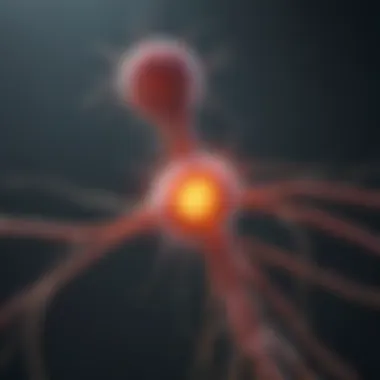Understanding Neurodegenerative Diseases: A Deep Dive


Intro
Neurodegenerative diseases represent a significant and growing challenge in the field of medical science. These conditions, characterized by the progressive degeneration of the structure and function of the nervous system, affect millions of individuals worldwide. The consequences these diseases have on brain health, cognitive function, and overall quality of life make them a crucial topic of study. Understanding the underlying mechanisms, types of diseases, and their socio-economic effects can shed light on the pressing need for further research and effective treatment strategies.
Research Overview
In recent years, studies have advanced our understanding of neurodegenerative diseases, highlighting critical insights into their progression and impact.
Summary of Key Findings
Research shows that neurodegenerative diseases often share common pathological features, such as the accumulation of misfolded proteins. Conditions like Alzheimer’s disease and Parkinson’s disease exhibit significant differences, yet they share similarities in their neuroinflammatory responses. The socio-economic impacts are profound, with increased healthcare costs and reduced productivity among affected individuals a common outcome.
Methodologies Employed
To gather these findings, researchers employ a variety of methodologies. Experimental studies often use animal models, like transgenic mice, to investigate disease mechanisms. Advanced imaging techniques, including MRI and PET scans, provide insights into brain changes over time. Epidemiological studies also play a vital role in assessing risk factors and prevalence.
In-Depth Analysis
The conclusions drawn from these methodologies offer a broad view of the complexities involved in neurodegenerative diseases.
Detailed Examination of Results
The data indicates that genetic predispositions and environmental factors contribute to the risk of developing these diseases. For example, mutations in the APP gene correlate with early-onset Alzheimer’s disease. In contrast, lifestyle choices, like diet and exercise, are linked to reduced risks, showcasing the interplay of genetics and lifestyle.
Comparison with Previous Studies
Comparing current findings with earlier research reveals both progress and ongoing challenges. Older studies often overlooked the role of neuroinflammation, which recent literature suggests is a critical aspect of disease progression. The shift towards understanding the immune response illustrates the evolving nature of research in this area.
In summary, comprehending the nuances of neurodegenerative diseases requires continual review of emerging findings and evolving methodologies. By staying informed, stakeholders can better advocate for affected individuals and push for advancements in treatment.
Through a focused exploration of neurodegenerative diseases, this article aims to provide a thorough understanding for students, researchers, educators, and professionals interested in brain health and the socio-economic implications of these debilitating conditions.
Prelims to Neurodegenerative Diseases
Neurodegenerative diseases represent a significant area of inquiry within the medical and scientific communities. Understanding these conditions is crucial as they affect millions of individuals and have profound impacts on overall quality of life, healthcare systems, and society. These diseases occur as a result of gradual degeneration of nerve cells in the brain and spinal cord. They manifest in various forms, including Alzheimer's, Parkinson's, Huntington's disease, and Amyotrophic Lateral Sclerosis (ALS). Each type poses unique challenges, both in diagnosis and treatment, underscoring the importance of comprehensive understanding.
Defining Neurodegeneration
Neurodegeneration is characterized by the progressive loss of structure or function of neurons, including death of neurons. It often leads to cognitive decline, motor dysfunction, and can severely affect daily life activities. The mechanisms causing neurodegeneration are complex and multifaceted, involving genetic, environmental, and pathological factors. Clear identification and definition of these factors are necessary for effective management and potential therapeutic development.
Clinically, neurodegeneration can be observed through a range of symptoms, which may vary significantly based on the affected areas of the brain. Key signs include memory loss, impaired reasoning, and changes in movement. A comprehensive approach to defining neurodegenerative diseases allows for better understanding and underscores the urgency of ongoing research.
Importance of Understanding Brain Health
Brain health encompasses cognitive, emotional, and behavioral well-being. It serves as the foundation for overall health and is vital for functioning in today’s complex world. As neurological disorders continue to rise, understanding brain health becomes imperative. More than just an academic pursuit, it can influence personal approaches to mental and physical health.
Maintaining brain health has implications not only for the individual but also for families and communities. This understanding aids in early detection, informed care decisions, and can contribute to improving quality of life for affected individuals. Furthermore, it encourages proactive health measures and promotes a broader conversation about prevention strategies in neurodegenerative diseases. Through various awareness campaigns and educational efforts, we can enhance public knowledge, which is essential for fostering a supportive environment for affected individuals.
Ultimately, understanding neurodegenerative diseases is not merely about studying conditions; it is about enhancing the lived experiences of those impacted.
Mechanisms of Brain Degeneration
Understanding the mechanisms of brain degeneration is crucial for grasping the nature of neurodegenerative diseases. This section explores the biological and biochemical processes that lead to the characteristic decline in brain function. Recognizing these mechanisms provides essential insights into the potential avenues for prevention and treatment, guiding both researchers and healthcare professionals in the ongoing battle against these conditions.
Cellular Changes in Neurodegeneration
Cellular changes are fundamental to the neurodegenerative process. Neurons, the primary cells of the brain, undergo various alterations that impair their function. One significant change is neuronal loss, which involves the death of brain cells. This occurs due to a variety of factors, including inflammation and excitotoxicity. When neurons are damaged, the brain's ability to communicate and process information diminishes.


Additionally, cellular alterations include dendritic atrophy. Dendrites are extensions of neurons that receive signals from other cells. When they shrink or disappear, communication between neurons is disrupted. This disconnection can lead to cognitive deficits seen in diseases like Alzheimer’s.
Changes in glial cells also play a role. These support cells maintain homeostasis and provide support for neurons. In many neurodegenerative diseases, glial cells become reactive, which can exacerbate the degeneration of neurons instead of protecting them. This dynamic interaction between neurons and glial cells is crucial in understanding the cellular landscape of neurodegeneration.
Role of Protein Misfolding
Protein misfolding is another critical element in the mechanisms of brain degeneration. Proteins must fold correctly to perform their intended functions. However, misfolded proteins can accumulate and form aggregates, which are toxic to neuronal cells. For instance, in Alzheimer's disease, beta-amyloid plaques are the result of aggregated misfolded proteins. These plaques disrupt neuronal function and trigger inflammatory processes that further damage brain tissue.
In Parkinson's disease, alpha-synuclein misfolding leads to the formation of Lewy bodies, which are characteristic of this condition. These aggregates impact dopamine-producing neurons, leading to motor symptoms. The study of protein misfolding has opened new pathways for research and potential therapeutic interventions aimed at correcting or preventing the misfolding process.
"Understanding the role of protein misfolding in neurodegeneration could lead to transformative treatment methods, improving quality of life for many patients."
Impact of Oxidative Stress
Oxidative stress emerges as a significant factor in neurodegenerative processes. It results from an imbalance between free radicals and antioxidants in the body. Excessive free radicals cause damage to cells, including neurons. This stress leads to lipid peroxidation, DNA damage, and protein oxidation, ultimately promoting cellular death and dysfunction.
Understanding oxidative stress is essential because it helps identify potential targets for intervention. Antioxidants, for example, may offer a protective effect against neurodegeneration. Some current research is focused on developing drugs that enhance the body's antioxidant defenses to mitigate these damaging effects.
Common Neurodegenerative Diseases
Neurodegenerative diseases are critical areas of study due to their profound effects on individuals and society. Understanding these diseases helps in identifying unique characteristics that can lead to better management and treatment options. The discussion of common neurodegenerative diseases not only brings attention to their symptoms and progression but also emphasizes the need for awareness in the healthcare community and public at large. Each disease presents its own set of challenges, which are relevant for clinicians and researchers alike.
Alzheimer's Disease
Symptoms and Stages
Alzheimer's Disease (AD) is notable for its distinct symptoms and stages of progression. Early symptoms often include memory loss, confusion, and difficulty in performing familiar tasks. As the disease advances, individuals may experience changes in behavior and personality, along with greater difficulty with language. Understanding these symptoms is crucial for early diagnosis, which can significantly affect the course of the disease. Early detection allows for potential interventions that could manage symptoms more effectively and improve quality of life.
A key characteristic of these symptoms is that they often vary by individual, making personalized assessment important. The unique feature of AD's stages is that they highlight the gradual decline in cognitive functions, which can inform caregivers and families about what to expect. However, one disadvantage is that these symptoms may be misattributed to normal aging, which could delay diagnosis and treatment.
Current Research and Treatments
In the realm of Alzheimer's research, focusing on current treatments is essential. Research is dedicated to understanding disease mechanisms, such as amyloid plaque formation and tau tangles, which are hallmark features of AD. A major characteristic is the exploration of drug therapies aimed at mitigating these effects, such as donepezil and memantine, which can help to manage symptoms.
The unique aspect of current research lies in its multi-faceted approach; it includes pharmacological treatments, lifestyle interventions, and new innovations like digital therapeutics. While these research efforts are promising, they also face challenges, such as varying efficacy among patients and the need for extensive clinical trials to validate findings.
Parkinson's Disease
Clinical Manifestations
Parkinson's Disease (PD) is characterized by a range of clinical manifestations, primarily motor symptoms such as tremors, rigidity, and bradykinesia. These symptoms develop gradually and can significantly impair daily functioning. Recognizing these manifestations is critical for timely diagnosis and effective treatment planning. Importantly, PD also encompasses non-motor symptoms such as depression and cognitive impairment, which can complicate the clinical picture.
The main benefit of spotlighting clinical manifestations is that they aid in differentiating PD from other similar neurological conditions. Understanding the full spectrum of symptoms offers significant advantages in patient management, communication with caregivers, and development of tailored therapeutic strategies.
Management Strategies
The management of Parkinson's Disease involves a comprehensive approach that includes medication, physical therapy, and lifestyle changes. Both levodopa and dopamine agonists play a fundamental role in managing motor symptoms by replenishing dopamine levels in the brain. This key characteristic of treatment underscores the need for a personalized treatment plan, as responses to medication can vary widely among patients.
One unique feature of management strategies is the increasing emphasis on holistic approaches, which also consider emotional and psychological well-being. While these strategies improve overall management of the condition, they also come with challenges, such as medication side effects and the need for continuous adjustment.
Huntington's Disease
Genetic Factors
Huntington's Disease (HD) is notable for its genetic origins. The disease is caused by a mutation in the HTT gene, which leads to progressive neurodegeneration. Understanding these genetic factors is integral to understanding disease mechanisms. The ability to screen for the genetic mutation presents opportunities for early diagnosis and potential therapeutic intervention that could delay onset.
A beneficial aspect of understanding genetic factors is that it provides clarity regarding disease transmission within families. This awareness can foster preemptive measures and informed decision-making among at-risk individuals. However, the unique feature of genetic testing can raise ethical concerns and emotional challenges among families facing the implications of the diagnosis.


Therapeutic Advances
In recent years, significant progress has been made in therapeutic advancements for Huntington's Disease. Research efforts focus on gene silencing techniques and symptomatic treatments to address cognitive and movement-related symptoms. The key characteristic of these therapeutic advances is their potential to alter the disease course fundamentally. Trials involving antisense oligonucleotides have shown promise in reducing the production of the mutant protein.
The unique feature of these advances is the focus on addressing the underlying genetic cause rather than just the symptoms. However, challenges remain, such as ensuring long-term safety and effectiveness of these new treatments, which require extensive clinical validation.
Amyotrophic Lateral Sclerosis (ALS)
Pathophysiology
Amyotrophic Lateral Sclerosis (ALS) involves complex pathophysiological mechanisms that lead to the degeneration of motor neurons. Understanding these mechanisms is crucial for developing effective therapeutic options. ALS manifests with both upper and lower motor neuron signs, causing muscle weakness and atrophy, which significantly impair mobility and communication.
The key characteristic of this disease's pathophysiology is its rapid progression and variability among patients. This understanding leads to important considerations regarding patient care and resource allocation. However, one challenge is that the exact causes of ALS remain unclear, hindering the development of targeted therapies.
Emerging Treatments
Emerging treatments for ALS focus on halting disease progression and improving the quality of life. One notable drug is edaravone, which has shown some effectiveness in slowing functional decline in certain patients. The unique aspect of emerging therapies is their innovative approaches, such as stem cell therapy and gene therapy focusing on neuroprotection.
Advancements in this area promise significant improvements in management strategies, although they also present challenges, including ethical considerations and high costs associated with such therapies.
"Continued research into neurodegenerative diseases is vital, not just for treatment, but for a deeper understanding of these complex conditions."
Understanding common neurodegenerative diseases positions us to better address the complexities these conditions introduce to individuals and society. Each disease presents unique characteristics and contributes to the larger context of neurodegeneration, underscoring the need for ongoing research and awareness.
Diagnosis and Assessment of Neurodegenerative Diseases
The diagnosis and assessment of neurodegenerative diseases hold significant importance in understanding these complex conditions. Early and accurate diagnosis can lead to better management strategies, improving the quality of life for patients. Moreover, it helps to identify the specific type of neurodegenerative disorder, which can vary widely in symptoms and progression. This section highlights clinical evaluation techniques, diagnostic imaging methods, and the role of biomarkers in establishing a correct diagnosis.
Clinical Evaluation Techniques
Clinical evaluation begins with a comprehensive medical history and physical examination. Understanding the patient's history is essential as it can reveal inherited conditions or environmental factors that contribute to the disease. Healthcare professionals look for behavioral changes, cognitive decline, or motor symptoms which may point toward particular diseases.
Various assessment scales, like the Mini-Mental State Examination (MMSE), are used to evaluate cognitive function systematically. These scales measure elements such as orientation, memory, and attention, providing valuable information about the disease's impact on the patient’s daily life. Another critical assessment involves neurological examinations that assess reflexes, coordination, and muscle strength, aiding in pinpointing the location of possible brain damage.
Diagnostic Imaging Methods
Diagnostic imaging plays a crucial role in diagnosing neurodegenerative diseases. Techniques such as magnetic resonance imaging (MRI) and positron emission tomography (PET) are widely utilized. MRI provides detailed images of brain anatomy and can identify structural changes common in diseases like Alzheimer’s and multiple sclerosis. PET scans, on the other hand, can show metabolic activity and help in detecting abnormal protein accumulations, such as amyloid plaques in Alzheimer’s disease.
An important distinction lies in the specificity of these techniques. For instance, MRI is more informative for structural changes, while PET offers insight into functional abnormalities. These imaging methods work in tandem with clinical findings, enhancing diagnostic accuracy and enabling a more comprehensive view of the patient’s condition.
Biomarkers in Diagnosis
Biomarkers are increasingly recognized as vital components in the diagnosis of neurodegenerative diseases. They can be found in cerebrospinal fluid, blood, or even imaging scans. Key biomarkers include tau proteins and beta-amyloid in Alzheimer's disease, which provide concrete evidence of the disease's pathology.
Moreover, the identification of neurofilament light chain (NfL), which may indicate neurodegeneration, is getting attention. Understanding these biomarkers helps create a holistic diagnostic approach. Additionally, as research advances, new biomarkers may emerge, further enhancing the precision of neurodegenerative disease diagnoses.
"Accurate diagnosis paves the way for effective treatment strategies, ultimately influencing the journey of patients living with neurodegenerative diseases."
Integrating these diagnostic techniques offers a comprehensive framework to assess and understand neurodegenerative diseases. Continuous updates in diagnostic criteria and methods ensure that healthcare providers can respond effectively, enabling timely intervention and support for affected individuals.
Societal and Economic Impact
Understanding the societal and economic impact of neurodegenerative diseases is crucial. This impact extends beyond the individual suffering from these conditions. It encompasses the broader implications for families, healthcare systems, and society at large. As the prevalence of neurodegenerative diseases increases, recognizing these effects becomes even more urgent.
Burden on Healthcare Systems
Neurodegenerative diseases place a significant strain on healthcare systems worldwide. They often require extensive management, leading to increased costs for both healthcare providers and patients. Patients with conditions like Alzheimer’s disease or Parkinson’s disease frequently need continuous care, resulting in heavy demands on medical facilities and professionals.


- Increased Hospital Visits: As the diseases progress, patients may experience complications leading to frequent hospitalizations.
- Long-Term Care Needs: Many patients require long-term care services. This includes nursing home placements which can be costly and resource-intensive.
- Resource Allocation: Healthcare resources often shift to manage these diseases, which can impact the availability of care for other conditions.
The financial burden is not just on healthcare systems; it significantly impacts public health budgets. In many countries, the rising costs of treating neurodegenerative diseases necessitates reallocating funds from other essential health services.
Impact on Families and Caregivers
The personal toll on families and caregivers facing neurodegenerative diseases is profound. Caregivers often experience emotional and physical stress as they manage the complex needs of their loved ones. This situation includes:
- Emotional Strain: Caregiving is often linked to feelings of isolation, depression, and anxiety.
- Work-Life Balance Challenges: Many caregivers find it difficult to maintain full-time employment while providing the necessary support.
- Financial Hardship: The costs associated with caregiving can lead to financial strain on families. This includes lost wages, medical expenses, and the costs of necessary tools or modifications to homes.
Despite the challenges, families become vital support systems for individuals with neurodegenerative diseases. Their role cannot be underestimated in the overall framework of care and management.
Research Funding Needs
Ongoing research is essential to address the challenges posed by neurodegenerative diseases. However, funding for this research often remains inadequate relative to the need. Key aspects include:
- Need for Innovative Treatments: To reduce the burden of these diseases, continuous investment in research to develop new therapeutic options is crucial.
- Understanding Disease Mechanisms: More funding could enhance our understanding of the underlying biological mechanisms that drive neurodegeneration.
- Public and Private Investment: Increased collaboration between the public and private sectors is necessary to elevate funding efforts for neurodegenerative disease research.
Overall, addressing the research funding needs not only supports the quest for cures but also alleviates the broader societal impact associated with these diseases. With the right resources, significant advancements can be made in the understanding and treatment of neurodegenerative conditions.
Current Research and Future Directions
Neurodegenerative diseases pose complex challenges that have become a major focus of scientific inquiry. Understanding the dynamics of these conditions is crucial, as they affect millions globally. Current research explores not only disease mechanisms but also innovative treatment methods and technological advancements that can improve patient management. The future directions in this field hinge on the integration of multidisciplinary approaches. By fostering collaboration among scientists, healthcare providers, and technology experts, we can enhance outcomes for patients battling these debilitating disorders.
Innovations in Treatment Approaches
Recent years have witnessed a surge in novel treatment strategies for neurodegenerative diseases. Scientists are investigating disease-modifying therapies that target the underlying biological processes rather than merely alleviating symptoms. For instance, monoclonal antibodies are being evaluated in clinical trials for Alzheimer's disease. These therapies aim to clear amyloid plaques, which are linked to cognitive decline. Additionally, gene therapy shows promise for conditions like Huntington's disease. Researchers are exploring methods to correct or silence faulty genes, potentially halting disease progression.
Clinical trials are essential for bringing these innovations to fruition. They help determine the safety and efficacy of new treatments. Engagement from diverse communities will be critical. Patient input can guide research priorities and assist scientists in understanding the lived experience of those affected.
Role of Technology in Management
Technology is reshaping how healthcare manages neurodegenerative diseases.Telehealth has emerged as a vital tool, especially during the COVID-19 pandemic. Patients can consult specialists from home, increasing access to expert care. Moreover, wearable devices offer real-time monitoring of symptoms. For example, smartwatches can track movement patterns in Parkinson's patients, allowing for timely interventions.
Digital platforms play a significant role in facilitating data sharing among researchers. This fosters collaboration and accelerates discovery processes. Mobile applications also enhance patient engagement by providing educational resources. They serve as reminders for medication adherence or appointment scheduling, thus improving care routines.
Future Research Priorities
Future research must focus on several critical areas to advance the understanding of neurodegenerative diseases. First, there is a pressing need to explore the genetic underpinnings of these conditions. The relationship between genetics and environmental factors also necessitates in-depth investigation, as it may reveal critical insights into disease onset and progression.
Second, researchers should prioritize studies that assess the long-term effectiveness and safety of emerging treatments. Developing robust biomarkers for early diagnosis is also vital. Early intervention may significantly alter disease trajectories, underscoring the importance of preventive strategies.
Finally, multidisciplinary approaches combining neurology, genetics, and technology will be essential to propel the field forward. Collaborative efforts can pave new pathways for innovative solutions to combat neurodegenerative diseases, not only improving lives but also reducing the substantial burden on healthcare systems worldwide.
Culmination
In the context of this article, the conclusion serves to encapsulate the profound issues concerning neurodegenerative diseases. This section synthesizes the research and findings presented earlier, illustrating why understanding these conditions is crucial for effective intervention and management. By summarizing critical insights gleaned from various studies, practitioners, researchers, and policymakers can appreciate the complexities of these diseases and their broader implications for society.
Summary of Key Insights
The exploration of neurodegenerative diseases reveals several pivotal points that stand out:
- Understanding Mechanisms: Grasping the underlying mechanisms of neurodegeneration, including protein misfolding and oxidative stress, is essential for developing more targeted therapies.
- Common Diseases: Alzheimer’s, Parkinson’s, Huntington’s, and ALS manifest distinct features, yet share common pathways of degeneration, which highlight the need for comprehensive treatment approaches.
- Socio-Economic Impact: The burden on healthcare systems and families is severe. Effective management of these diseases can diminish long-term economic impacts.
- Research Directions: Continued innovation in treatment approaches and technology must be prioritized to ensure future advancements in care for affected individuals.
This summary highlights the interconnections between brain health and societal welfare, emphasizing the importance of a multi-disciplinary approach to understanding these diseases.
Call for Continued Research and Awareness
The challenges posed by neurodegenerative diseases necessitate an ongoing commitment to research and public awareness. Here are several reasons this is vital:
- Emerging Knowledge: Our understanding of neurodegeneration is still evolving. Ongoing research is essential to uncover new insights and refine existing knowledge.
- Public Education: Many societal misconceptions exist regarding these diseases. Public awareness can help foster a supportive environment for patients and their families.
- Policy Advocacy: Increased awareness can lead to better funding initiatives for research and more comprehensive healthcare policies.
- Integration of Technology: Advancements in technology will inevitably play a key role in disease management. Continuous exploration will help identify effective applications in patient care.
In summary, the realm of neurodegenerative diseases is complex, warranting sustained research efforts and proactive dissemination of knowledge. Such initiatives will ultimately enhance understanding and support for individuals and families impacted by these conditions.















